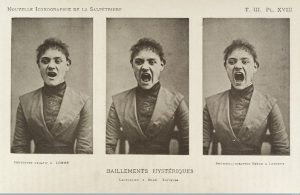Britney Spears, Hysteria, and the History of Invalidating Mental Illness in Women
– contains mentions of exploitation, sexualisation of minors, mental illness and mdical gore –
The Princess of Pop
Born in 1981, Britney Jean Spears is one of the most influential popstars of the 1990s and early 2000s. In 24 years of career, Spears has sold more than 100 million records worldwide, making her one of the best-selling artists worldwide. Known as the “Princess of Pop” she is credited with influencing the revival of teen pop music. Since signing her first record deal at age 15, Spears has released 9 studio albums, featured in multiple movies, and received many awards, including a Grammy.
After minor acting jobs as a young child, including a role on The Mickey Mouse Club her debut album “…Baby One More Time” was released in 1999. At age 17, the album and lead single of the same name made Spears an overnight success. This success would only be expended on. In the next years, Britney Spears released more albums, most of which became critically acclaimed and commercial successes.

1 Britney performing in 1999 at age 17
It is to be noted that Spears appealed to a sexualized ideal from a young age. Having only been sixteen at the time of shooting, she appears in the “…Baby One More Time” music video wearing a cropped blouse and short skirt, as well as pigtails. The “sexy schoolgirl” became her signature and although she was being criticized for it, she continued sporting outfits that showed her figure, even when she was still underage. Unfortunately, this framing fed into the media’s and the public’s obsession with teenage girls’ sexuality. It became a regular occurrence that interviewers would ask Britney, who was still a minor at the time, about her dating life and whether she had lost her virginity yet.
Spears married Jason Allen in 2004 and got the marriage annulled only 55 hours later. In the same year, she became engaged to Kevin Federline, whom she had met three months prior. Both relationships were the subjects of intense media attention and Spears was being ruthlessly criticized and bullied for being “flaky” and getting engaged to a man who had only recently broken up with his pregnant girlfriend. Most of the critics focussed on Spears.
The young star was now constantly harassed by paparazzi, who followed her every step and intruded on her privacy in hopes of getting a picture that would sell well. A lot of these pictures led to Britney being ripped apart in the press for her appearance, the treatment of her children, and the people she spent time with. At this time, Spears’ struggles with mental illness and drug abuse became more heavily publicized. After spending a single day in a drug rehabilitation facility, she shaved her head at a hair salon and beat a car with an umbrella. This incident was heavily publicized and led to Spears being widely regarded as “crazy” and “out of control”. It likely also played a role in the 2007 court hearing, in which Spears lost the physical custody of her sons to ex-husband Federline. Even during this time, Spears kept releasing music and performing.
In January 2008, Spears refused to resign her sons to Federline’s representatives. Police arrived and determined she was under the influence of an unidentified substance. She was hospitalized and Federline was given sole and full custody of their sons. Spears’s visitation rights were suspended. After being put on involuntary psychiatric hold under California state law she was admitted to a psychiatric hold in Los Angeles. A court placed her under a conservatorship led by her father, Jamie Spears, and attorney Andrew Wallet. This gave them complete control of all her assets. She was 26 at the time.
Under U.S. law, a conservatorship is the appointment of a guardian by a judge to manage the financial affairs and daily life of another person due to old age or physical or mental limitations. In 2008, Spears lost control of the multi-million-dollar empire she had spent her life building. The court took away a grown woman’s rights to make basic decisions about her finances, career, and personal life.

2 Spears at The Femme Fatale Tour in 2011
As her autonomy was taken from her, Spears was quick to object to the conservatorship and her father’s role in it. Reporting has since revealed that she tried to hire her own lawyer to advocate for her in the conservatorship hearings. However, the courts ruled that she did not have the mental capacity to select her own legal counsel and instead gave her a court-appointed lawyer, Samuel Ingham. The conservatorship arrangement forced Spears to pay Ingham, her father, his legal team, and other people involved in the case. As the New York Times reports, Spears strongly objected to the arrangement for years, but Ingham, who made an estimate of 3m dollars off representing the popstar, did not advocate for the conservatorship to end. In 2016, Britney outlined a strange system of abuse to a court investigator, as the records show. Allegedly, she had been forced to perform while sick with a fever, her security team held her credit card and used it whenever they wanted, she was limited to a weekly allowance, forbidden to make changes to her birth control method, and her father prohibited her from making cosmetic changes to her house. As the Times also reported, she allegedly had been institutionalized in a mental health facility against her will after speaking up during a rehearsal.
Despite these immense objections, which at the time had been private, the conservatorship continued for multiple years. Recently, Ingham had begun raising concerns over Jamie’s treatment of his daughter, citing in court how Britney was “afraid of her father”. However, the lawyer did not file for the conservatorship to end.
A Quick History of Hysteria and Emotional Invalidation

3 Series of three phtots showing a hysterical yawning woman, 1890
In the western world accusing women of insanity has long served as a tool of oppression. In the 19th century, male physicians began to establish the concept of “female hysteria” as a legitimate medical diagnosis. This “condition” was said to be at the root of a myriad of symptoms such as mood changes, several symptoms which today are attributed to depression, anxiety, or PTSD, tears, laughter, enjoying writing, or pain. Over centuries, women were being misdiagnosed with hysteria, when in reality they suffered from a myriad of real mental and physical illnesses or were dealing with abusive relationships or other traumata. To treat this “disease” doctors shut women up in insane asylums, prescribing them masturbation, or giving them “rest cures” which was essentially just a fancy term for solitary confinement. This meant that a woman struggling with her mental health could be and frequently was locked up in her rooms or an asylum by a close male relative, more often than not her husband. As men’s accounts were generally regarded as more valuable than women’s a lot of men were able to simply get rid of their wives, daughters, and other female relatives by going to a doctor and claiming she was “hysterical”. And they did so under the guise of protecting her and caring for her.
Furthermore, getting locked up in an asylum isn’t the worst that could happen to a woman struggling with trauma and mental illness. Enter the hysterectomy, a medical procedure in which doctors would remove a woman’s uterus (without her consent). Since hysteria was thought to be a disease of the uterus (hystera in Greek) doctors thought that removing it would ‘cure’ the woman. This would often add to the women’s trauma and drastically worsen their social standing as well as physical and mental health, as she was now no longer able to bear children. The procedures were often connected to immense risks and many of the women never fully recovered.

4 Diagram of the skull and site of borehole for the standard per-frontal lobotomy
Starting in the 1930s, lobotomies became a widespread way of ‘healing’ people from mental disorders and illnesses. A lobotomy is a psychosurgical procedure where nerve fibers connecting the frontal lobe of the brain and the thalamus are severed. This was originally accomplished by drilling into a patient’s head and later advanced to an easier method of inserting a steel rod resembling an ice-pick, under the eyelid and into the brain. And although lobotomies were used on people of any gender for a multitude of problems, the majority of patients who received lobotomies were women. While some patients’ conditions improved post-lobotomy, an overwhelming amount reported serious, sometimes severe complications and impairments. These included seizures, speech impairments, bodily impairments, personality changes, and many more. Men could give the order for their wives to undergo these horrific procedures and a woman’s consent wasn’t always needed. This infringes on a woman’s human rights, as their right to life, liberty, and security was taken from them. After almost two decades of commonplace use of lobotomies the procedure was judged to be inhumane and the risks as too high and it was outlawed.
And while Britney Spears isn’t locked up in a small room somewhere or being lobotomized, she is being denied access to the money she earned and any amount of autonomy that should be granted to any grown person. Her father has been reported to take away her phone, effectively cutting her off from the outside world. Brian Spears, Britney’s brother has openly claimed that the conservatorship of his sister is necessary because the women in his family have a way of being very outspoken and having things their way. According to him, the arrangement is in place to help Britney thrive and be protected. The way Britney is being treated by her relatives and the media call back to the times of “hysteria”. From an incredibly young age, Britney and her struggles have been gawked at and fetishized. After years of constant hounding by paparazzi and never-ending media scrutiny, Britney was struggling with severe mental illness. Her anger, refusal to smile for the cameras and pretend everything was good and her final outburst to the distress caused by years of mistreatment gave her father and a group of other people in her life the chance to shut her up and take control of her assets. A lot of people, including but not limited to Jamie Spears, his legal team, and Samuel Ingham, benefited greatly from her conservatorship.
#FreeBritney
In February of 2019 a fan podcast, Britney’s Gram, released a voicemail message from a source who allegedly used to belong to Britney’s security team. They alleged that Jamie Spears had canceled his daughter’s Las Vegas concert residency that had been successfully running for four years because she refused to take her medication. Furthermore, they claimed Britney was being held in a psychiatric facility because she had previously violated a no-driving rule he had imposed and that her conservatorship had been supposed to end in 2009. The allegations went viral and gave way to a movement to terminate the conservatorship. The movement was organized under #FreeBritney and gained a large following with major celebrities joining to advocate for the singer’s freedom. In the beginning, Spears disapproved of the protests in her honor, insisting “all [was] well”.
In May, Jamie was temporarily removed from the conservatorship after Federline (the ex-husband) got a restraining order against him. This happened after Jamie allegedly got into a physical altercation with one of Spears’s sons.

5 Protest of the #FreeBritney movement in Washington, DC in July of 2021
In February of 2021, the documentary Framing Britney Spears about her life and conservatorship premiered on streaming service FX. Spears publicly disapproved of it, claiming many of the alleged instances of abuse to be false. In a June court hearing, Spears finally called the conservatorship “abusive” and said she had lied about being ok and happy. As this was the first time Britney publicly criticized her conservatorship, the statement got widespread media coverage.
On July 1, two U.S. senators called on federal agencies to increase oversight of the country’s conservatorship system. Later that month, two of the lawyers involved in the conservatorship, including Samuel Ingham, resigned from their positions. Spears was allowed to hire lawyer Mathew Rosengart to represent her, who immediately started working on terminating the conservatorship. Spears publicly endorsed #FreeBritney on July 14. Twelve days later Rosengart filed a petition seeking to replace Jamie as conservator. On August 12, Jamie agreed to step down in the future as soon as an appropriate replacement for his position was found.
On November 12 of 2021, a LA judge terminated the conservatorship. After almost 14 years of her father having control over everything from her grocery list to her method of birth control, Britney Spears, now 39, was finally free.
Justice
The life and conservatorship of Britney Spears shine a light on a problematic conservatorship system, that allows for an adult woman’s choices to be taken away for almost 14 years. It also draws back to past times, in which women were seen as the property of the closest male relative.
Though Britney Spears managed to escape the system in the end, thousands of others don’t have the reach or support that got Britney to where she is today. While the exact figures are unknown, it is estimated that millions of people with intellectual and psychosocial disabilities are deprived of legal capacity and placed under some form of guardianship. They are deemed unable to make their own decisions simply because they have a disability. These practices can be extremely harmful and can lead to a range of abuses, including forced treatment, involuntary confinement, forced abortions or contraceptives, forced living arrangements, and limited freedom of movement.
The system is incredibly ableist and discriminates against mentally ill people. Instead of relying on conservatorships and thereby taking away people’s freedoms and denying them their human rights, governments should work to provide a system of support for decision-making that respects the autonomy, will, and preferences of the person with the disability or mental illness.
Photos via Wikimedia
z4l9wp
xnok3j
afnijr
naaqnn
48gpld
xbtrz0